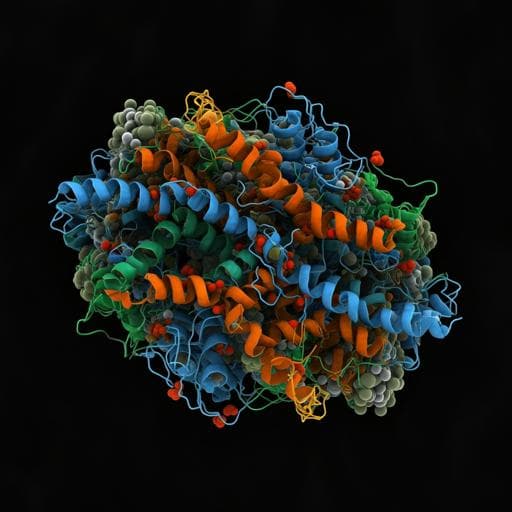
Biology
A rational blueprint for the design of chemically-controlled protein switches
S. Shui, P. Gainza, et al.
Discover an innovative computational protein design strategy that transforms drug-inhibited protein interactions into functional OFF- and ON-switches, enhancing cellular activities in synthetic circuits. This exciting research was conducted by Sailan Shui, Pablo Gainza, Leo Scheller, Che Yang, Yoichi Kurumida, Stéphane Rosset, Sandrine Georgeon, Raphaël B. Di Roberto, Rocío Castellanos-Rueda, Sai T. Reddy, and Bruno E. Correia.
~3 min • Beginner • English
Introduction
Synthetic biology relies on chemically controlled protein switches to modulate timing, localization, specificity, and strength of cellular activities, but current switches are limited by drug toxicity/side effects, unfavorable pharmacokinetics, and potential immunogenicity of non-human components. Widely used systems such as rapamycin-induced CIDs (FKBP:FRB) illustrate the utility of small-molecule control, yet safety and translational constraints motivate expanding the available chemical and protein switch space. Prior efforts have engineered CIDs using in vitro evolution, de novo scaffold design, and computational ligand-binding site transplantation; however, accurately designing small molecule–mediated interactions remains challenging. Chemical disruption systems are comparatively underexplored despite their utility. The authors hypothesize that protein–protein interactions with known small-molecule inhibitors can be repurposed into chemically disruptable heterodimers (OFF switches) and, via a rational architecture, into ON switches that heterodimerize upon drug addition. The aim is to broaden the toolbox of orthogonal, clinically relevant switches with tunable properties for diverse intracellular and extracellular applications, and to enable multi-input/multi-output control in engineered mammalian cells.
Literature Review
The field has long used chemically induced dimerizers (CIDs), notably rapamycin-controlled FKBP:FRB, to regulate cellular processes, including CAR-T safety switches. Limitations include drug toxicity, pharmacokinetics, and immunogenicity of non-human components. Recent expansions include: (1) antibody-based CIDs that recognize Bcl-XL only in the drug-bound state (Hill et al.), (2) designed scaffold libraries to bind a viral protease in its drug-bound state (Foight et al.), and (3) rational design of a CID by transplanting ligand binding sites to a protein dimer (Glasgow et al.). These advances underscore the difficulty of precisely designing small molecule interactions. Chemical disruption systems have been less explored despite applications, with early ligand-reversible dimerization systems and ER aggregation-based secretion control. Clinical development of PPI inhibitors (e.g., Bcl-2 family, mdm2) provides an attractive chemical space for synthetic biology. The authors’ prior work created a chemically disruptable heterodimer (CDH-1) by grafting BIM-BH3 onto a stable scaffold (LD3) to bind Bcl-XL and be disrupted by A-1155463, functioning as an OFF switch for CAR-T activity in vivo.
Methodology
Design and construction:
- OFF-switch (CDH) design: Repurposed PPIs with known small-molecule inhibitors. Built CDH-2 by pairing LD3 with Bcl2 to be disrupted by Venetoclax (Drug-2). Built CDH-3 by grafting the p53 helical motif (from PDB 5AFG) onto monomeric protein scaffolds using Rosetta MotifGraft and fixed-backbone design. Screened ~11,000 scaffolds filtered by RMSD, steric compatibility, energetics, globularity (G ≥ 0.9), and manual inspection. Selected LD4–LD6; LD6 (thioredoxin-like scaffold) was monomeric, thermostable, and bound mdm2.
- Affinity tuning: Performed computational alanine scanning on LD3 (in Bcl-XL complex PDB 6IWB). Selected E22A, R134A, D138A to generate lower-affinity variants (LD3_v1–v3) spanning picomolar to nanomolar affinities.
- ON-switch (AIR) architecture: Two-chain system. Chain 1: fused intramolecular CDH (LD3–flexible linker–drug receptor). Chain 2: rationally designed drug-insensitive receptor that retains binder affinity. Drug addition releases LD3 from Chain 1 to bind Chain 2, inducing dimerization.
- Multistate design for drug-insensitive receptors: Positive design (retain LD3 binding) and negative design (disrupt drug binding) using Rosetta energy scoring on selected drug-pocket residues. For Bcl-XL (Drug-1) residues E98, R102, F105, T109, S145, A149; for Bcl2 (Drug-2) residues A100, D103, V148, V156, Y202. Selected iBcl-XL_v3 (R102E, F105I) and iBcl2_v4 (A100V, D103N, Y202H).
Biophysical characterization:
- SPR (Biacore 8K): Immobilized receptors (Bcl-XL, Bcl2, mdm2) on CM5; measured LD3/LD6 binding kinetics (1:1 Langmuir model). Drug-competition assays mixed binders (4 µM) with serial drug dilutions (10 µM to 0.01 nM) and injected over receptor to determine apparent IC50.
- SEC-MALS: Assessed oligomeric state and drug-induced dissociation for complexes (e.g., mdm2:LD6, Bcl2:LD3) ± drugs.
- X-ray crystallography: Solved mdm2:LD6 complex at 2.9 Å (space group P43212). Molecular replacement with mdm2 from 5AFG and LD6 model; refined in Phenix; assessed RMSDs vs model and p53 motif.
Cell-based systems and assays:
- Cell culture: HEK293T in DMEM + 10% FBS. Transfections via Lipofectamine 3000.
- Toxicity: CCK-8 viability assay for Drugs 1–3 (0–10 µM).
- OFF-switch circuits: CDH-TFs (split TF: Gal4DBD fused to one CDH component; RelA/p65 activation domain fused to the other) driving SEAP reporter. CDH-GEMS: CDH ectodomains fused to EpoR-based GEMS receptors to drive JAK/STAT and SEAP.
- ON-switch circuits: AIR-GEMS assembled with iBcl-XL_v3 or iBcl2_v4 (Chain 2) and fused CDH (LD3–linker–Bcl-XL or Bcl2; Chain 1). AIR-TFs analogous to CDH-TFs for transcriptional activation (SEAP); also used to control anti-HER2 CAR expression measured by flow cytometry.
- Reporter quantification: SEAP activity at 405 nm; luciferase for certain TF assays. Dose–response curves (four-parameter nonlinear regression). Reversibility by intermittent drug treatments.
Compounds:
- A-1155463 (Drug-1), Venetoclax/ABT-199 (Drug-2), NVP-CGM097 (Drug-3); 10 mM DMSO stocks.
Data and code:
- Structural coordinates deposited (PDB 7AYE). Design code available at https://github.com/LPDI-EPFL/CDH_AIR (DOI: 10.5281/zenodo.5155700).
Key Findings
- New chemically disruptable heterodimers (CDHs):
• CDH-2 (Bcl2:LD3) bound with K_D ≈ 0.8 nM; disrupted by Venetoclax (Drug-2) with apparent IC50 ≈ 67.5 nM (SPR); SEC-MALS confirmed dissociation.
• CDH-3 (mdm2:LD6) bound with K_D ≈ 4.19 nM; disrupted by NVP-CGM097 (Drug-3) with IC50 ≈ 106 nM (SPR); SEC-MALS confirmed.
• Structural validation: mdm2:LD6 crystal structure at 2.9 Å closely matched design (backbone RMSD 0.37 Å overall; 0.24 Å over p53 motif hotspots).
- Cellular OFF-switch performance:
• CDH-TFs (intracellular): 3–10-fold dynamic reduction at 1 µM drug; with increased exposure/promoter tuning achieved up to 14-fold and 21-fold (CDH-1) and 13-fold (CDH-3). Dose-dependent IC50s: CDH-1-TF 9.6 nM; CDH-2-TF 33.5 nM; CDH-3-TF 540 nM. Responses were drug-specific and reversible.
• CDH-GEMS (extracellular): 6–8-fold dynamic ranges; dose-dependent IC50s: CDH-1-GEMS 1.7 nM; CDH-2-GEMS 23 nM; CDH-3-GEMS 149 nM. Specific and reversible; generally lower IC50s than intracellular TFs, consistent with permeability effects.
- Affinity tuning increased drug sensitivity:
• LD3 variants decreased affinity to Bcl-XL from K_D ≈ 4 pM (LD3) to 22.3 nM (LD3_v3), and to Bcl2 from 0.79 nM to 147 nM. In vitro Bcl-XL IC50s improved from 101.4 nM (LD3) to 14.6 nM (LD3_v3); Bcl2 IC50s from 71 nM to 19.5 nM. In cells, LD3_v3 reduced CDH-GEMS IC50s by up to 21-fold (Bcl-XL-based), demonstrating that weakening PPI increases drug sensitivity.
- ON-switches (AIR):
• Designed drug-insensitive receptors retained binder affinity while resisting drug.
– iBcl-XL_v3 (R102E, F105I) maintained LD3 binding (K_D ≈ 3.8 nM) and resisted Drug-1 up to 10 µM in vitro and in cells.
– iBcl2_v4 (A100V, D103N, Y202H) retained LD3 interaction (K_i ≈ 9.8 µM) and resisted Venetoclax in vitro and in cells.
• AIR-1-GEMS (Drug-1): ON activation with EC50 = 18.68 ± 4.65 nM; 64-fold dynamic range (100 nM Drug-1).
• AIR-2-GEMS (Drug-2): ON activation with EC50 = 0.5 ± 0.27 nM; lower maximal output than AIR-1-GEMS, consistent with affinity differences.
• AIR-1-TF: 13-fold activation; EC50 ≈ 75 nM; successfully induced anti-HER2 CAR expression upon Drug-1 treatment.
- Orthogonal multi-input/multi-output control:
• MIMO: Co-expression of AIR-1/2-GEMS (SEAP, ON) with CDH-3-TF (luciferase, OFF) yielded orthogonal dual-drug control without cross-talk.
• MISO: Dual OFF circuits (CDH-1-TF/CDH-3-TF or CDH-1-GEMS/CDH-3-GEMS) produced three persistent output levels (high/medium/low) under combined drugs, enabling graded, robust responses.
• SIMO: Single drug (Drug-1 or Drug-2) simultaneously drove ON via AIR-GEMS and OFF via CDH-TF for two outputs, demonstrating one-compound control of antagonistic outputs.
- General: All three drugs were tolerated up to 10 µM in HEK293T cells; CDHs and AIRs were reversible and drug-specific.
Discussion
The study addresses a key limitation in synthetic biology—the paucity of safe, orthogonal, and clinically compatible small-molecule switches—by repurposing PPIs with known inhibitors into versatile OFF (CDH) and ON (AIR) systems. Biophysically validated designs (including a close-to-model crystal structure for mdm2:LD6) confirm the robustness of motif-grafting and multistate design methodologies. In cells, CDHs function effectively in both intracellular transcriptional and extracellular receptor signaling contexts with reversible, dose-dependent, drug-specific control. Affinity tuning demonstrates that weakening PPI interfaces increases drug sensitivity, enabling lower effective doses that may mitigate toxicity. The AIR architecture converts monomerization-inducing modules into dimerization-inducing ON switches using drug-insensitive receptors, achieving low-nanomolar to sub-nanomolar EC50s and substantial dynamic ranges. Combining orthogonal CDH and AIR modules yields higher-order logic (MIMO, MISO, SIMO), including the unique capability for a single drug to simultaneously toggle antagonistic outputs. Together, these findings expand the chemical and protein component spaces for cell engineering and provide a practical, generalizable blueprint to design small-molecule-responsive switches for complex cellular control.
Conclusion
This work establishes a rational, structure-driven approach to create chemically controlled protein switches by repurposing inhibitor-targeted PPIs. Three OFF switches (CDH-1–3) controlled by distinct drugs (including FDA-approved Venetoclax) and affinity-tuned variants were engineered and validated biophysically and in mammalian cells. A new ON-switch architecture (AIR) was developed via multistate design of drug-insensitive receptors, enabling sensitive, drug-induced heterodimerization with robust activation in both receptor and transcriptional systems, including control of CAR expression. Orthogonal integration of CDH and AIR components produced advanced multi-input/output behaviors (MIMO, MISO with three persistent levels, SIMO). Future directions include expanding to additional clinically validated PPI inhibitor chemotypes, optimizing receptor–binder affinities for desired cellular performance, testing in therapeutically relevant cell types and in vivo, and developing fully humanized components to minimize immunogenicity.
Limitations
Observed non-linear translation between in vitro binding affinity changes and cellular IC50/EC50 shifts highlights complexity of intracellular milieu and signaling context; affinity reductions of >5000-fold resulted in only ~11–26-fold shifts in cellular responses. Achieving complete drug orthogonality in cells is challenging; potential off-target effects and permeability differences can influence performance. Some designed drug-insensitive receptors (e.g., iBcl2_v4) retained relatively weak binder affinity in vitro (K_i in the micromolar range) yet functioned within the AIR architecture, suggesting architectural compensation but also indicating room for optimization. Experiments were conducted primarily in HEK293T cells; generalizability to other cell types and in vivo settings remains to be demonstrated. Drug safety and pharmacokinetics, while improved by lower-dose operation via affinity tuning, must still be evaluated in application-specific contexts.
Related Publications
Explore these studies to deepen your understanding of the subject.







